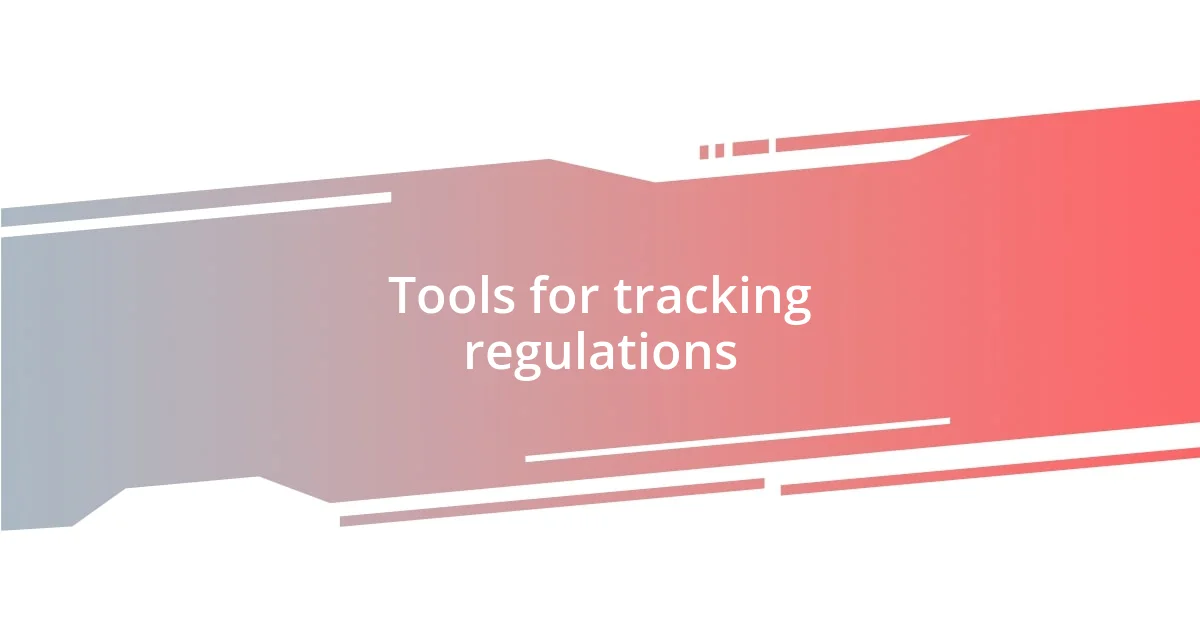Key takeaways:
- Understanding the reasons behind regulatory changes fosters adaptation and can inspire advocacy for better practices.
- Staying updated on regulations mitigates risks and creates opportunities for growth, encouraging ethical conduct within industries.
- Engaging with regulatory bodies and investing in team training enhances compliance efforts and builds a culture of continuous learning.

Understanding regulatory changes
Understanding regulatory changes is like trying to catch smoke with your bare hands; it’s constantly shifting and evolving. I recall a time when a particular regulation came into effect almost overnight, leaving many in my industry scrambling to align. Have you ever felt caught off guard by sudden changes? It can be overwhelming, but it’s essential to recognize that these changes often stem from a desire to improve safety, fairness, and accountability.
Often, I find that grasping the underlying reasons behind regulatory shifts can illuminate their true significance. For instance, during a recent regulatory overhaul concerning data privacy, I dug into the motivations behind the changes. It wasn’t just about compliance; it was about ensuring that individuals’ rights were respected in our increasingly digital world. Understanding this context not only helped me adapt but also sparked a passion for advocating better practices.
When I think about regulatory changes, I like to visualize them as a conversation between governing bodies and the industries they oversee. Each new regulation introduces a dialogue that can open doors to innovation and improvement. Have you ever found yourself envisioning the possibilities these changes could bring? Embracing this viewpoint can transform how we perceive and respond to the regulatory landscape.

Importance of staying updated
Staying updated with regulatory changes is crucial because it prevents unpleasant surprises. I remember when my company missed a significant update regarding environmental regulations that resulted in hefty fines. It’s like driving blind—you never know where the bumps in the road are until it’s too late. By staying informed, you can navigate the landscape with confidence and foresight.
In my experience, being proactive about regulatory updates isn’t just about avoiding fines; it’s about harnessing opportunities for growth. I once leveraged an emerging regulation that favored renewable energy sources to pivot my business strategy. This not only aligned with compliance but also boosted our market positioning. Have you considered the potential advantages that come alongside regulatory changes? Staying updated empowers you to turn challenges into stepping stones toward success.
Moreover, the importance of staying current extends beyond individual businesses; it contributes to a broader sense of accountability within industries. I often think of regulatory updates as a wake-up call for everyone involved. They push us to reflect on our practices and ask difficult questions. Is your business truly committed to ethical standards? By embracing these updates, we cultivate a culture of responsibility and trustworthiness, which ultimately benefits us all.
| Reason | Implication |
|---|---|
| Prevention of Surprises | Mitigates risks and possible penalties |
| Opportunity for Growth | Aligns business strategy with new regulations |
| Accountability in Industry | Encourages ethical practices and trust |

Tools for tracking regulations
To effectively track regulatory changes, employing the right tools is essential. I’ve found that a combination of digital platforms and traditional resources can keep me grounded. For instance, leveraging regulatory tracking software not only saves time but also provides alerts on changes that might impact my field. I’ve personally experienced the relief of having these notifications at my fingertips. There’s something comforting about knowing that I’m not alone in monitoring the ever-shifting landscape.
Here are some tools that I’ve successfully used:
- Regulatory Tracking Software: Platforms like ComplyAdvantage and PolicyStat can provide real-time updates.
- News Aggregators: Tools like Feedly help to curate industry news, allowing me to tailor the information I consume.
- Email Alerts: Subscribing to newsletters from professional associations ensures I receive direct updates.
- Social Media: Following relevant regulatory bodies on platforms like Twitter gives me instant access to announced changes.
In my journey of regulatory compliance, I’ve discovered that each tool serves its own purpose, and surprisingly, collaboration is equally vital. For example, when I was part of a team tasked with adapting to new compliance standards, sharing insights from various tools created a broader understanding. It’s fascinating how the collective knowledge enhances the ability to respond swiftly and effectively, turning an otherwise daunting task into a manageable process.

Building a compliance calendar
Building a compliance calendar is essential for staying ahead of regulatory changes. When I first initiated this practice, I didn’t realize how much clarity it would bring to my operations. By mapping out key dates and deadlines for regulations, I felt like I had a roadmap guiding me through the compliance landscape. It allowed me to visualize what needed attention and when—transforming a seemingly overwhelming task into manageable steps. Have you ever felt less anxious about a project when you can clearly see what’s ahead?
In my experience, the most effective compliance calendars are living documents. They should evolve as regulations change and as you learn from your interactions with them. One moment that stands out was when I discovered a regulatory shift a month prior to its implementation. Because I had my calendar in place, this allowed me to prepare my team adequately, sparking a collaborative effort to adjust our processes seamlessly. It was rewarding to witness how readiness breeds confidence, transforming stress into an opportunity for growth. How do you currently keep track of your compliance timelines?
Incorporating reminders into the calendar is another impactful strategy. I like to think of them as gentle nudges that keep the team focused. For instance, setting up automated alerts a week in advance of significant deadlines ensures nothing slips through the cracks. When I first started using reminders, I underestimated their power. I was surprised at how much smoother our operations became when everyone was informed well ahead of time. Have you found that team awareness can drive better outcomes in your compliance efforts?

Engaging with regulatory bodies
Engaging with regulatory bodies has been one of the most insightful parts of my compliance journey. I remember my first interaction with a regulatory agency; it felt intimidating, like standing in front of a seasoned expert. But as I learned to present my questions clearly and professionally, I discovered that these representatives genuinely want to help. Have you ever found that connecting directly with those who shape the rules can turn fear into understanding?
Regularly attending industry forums and workshops has also deepened my connection with regulatory bodies. I once attended a conference where a regulatory official spoke candidly about upcoming changes and took questions from the audience. It was an eye-opening experience; I realized how valuable it is to hear directly from the source. Engaging in such settings not only clarifies my concerns but also fosters a community where we can collectively navigate the complexities of compliance. Have you explored opportunities to speak face-to-face with regulators about your challenges?
Building relationships over time has proven essential. I’m sure you’ve noticed that a simple follow-up email can make a difference. One time, after an inquiry about a regulatory update, I sent a thank you note to the official who responded. This small gesture opened the door for future conversations, making it easier to seek guidance when necessary. I believe fostering these connections transforms compliance from a checkbox exercise into a collaborative journey. How do you approach building rapport with regulatory agencies in your field?

Training and resources for teams
Investing in training for your team is critical to navigating regulatory changes effectively. I recall a workshop where we delved into the nuances of compliance requirements. It was an eye-opener for not just me but my entire team. The lively discussions and role-playing scenarios boosted our confidence in addressing real-world compliance challenges. How often do you engage your team in these learning opportunities to enhance their understanding and skills?
Resources play a pivotal role in keeping your team informed. I’ve found that curated reading lists and access to online courses can make a significant difference. We started sharing bi-weekly articles that summarize regulatory changes, followed by informal team discussions to solidify our grasp on the material. This approach not only kept us up-to-date but also fostered a sense of camaraderie. Have you noticed how sharing knowledge can spark motivation and engagement within your team?
Moreover, I believe mentorship within teams can amplify learning experiences. When I partnered experienced members with newer team members, I witnessed a transformation in our overall comprehension. The newer team members felt empowered asking questions, while the veterans enjoyed passing on their knowledge. This dynamic has created a culture of continuous learning. Have you explored mentorship as a resource for building a knowledgeable compliance-conscious team?

Evaluating the impact of changes
Evaluating the impact of regulatory changes requires a multifaceted approach—not just skimming the surface. I often dive deep into understanding how these changes affect our operations and the broader industry. Just recently, I analyzed a new regulation that altered our reporting requirements. It struck me how shifting one small piece in the compliance puzzle could lead to a domino effect, impacting workflows and employee training.
I also reflect on the human side of compliance changes. During a recent assessment, I gathered feedback from my team about how a new regulation affected their daily tasks. The candid responses highlighted areas where we needed adjustments, showing me that compliance is not just about rules—it’s about people navigating them. Have you considered how your team’s experiences could guide your evaluation of compliance impacts?
Incorporating quantitative data into this evaluation is crucial. I remember implementing a tracking system to measure compliance metrics after a regulatory shift. Analyzing this data revealed trends I hadn’t anticipated, allowing us to proactively address issues. It has been enlightening to see how such metrics can provide clarity and direction, transforming confusion into actionable insights. How do you ensure your evaluations are both comprehensive and precise?















